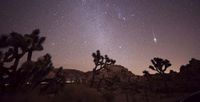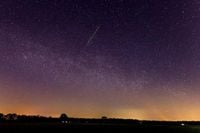Sky gazers are in for a treat as the Lyrid meteor shower peaks tonight, offering a spectacular display of shooting stars. This annual event, one of the oldest recorded meteor showers, is expected to showcase between 10 and 100 meteors per hour, with the best viewing time set between 4 and 6 a.m. on April 22, 2025.
The Lyrids, which occur every April as Earth passes through the debris trail left by Comet Thatcher, will be most visible in the Northern Hemisphere. According to the American Meteor Society, viewers should look towards the northeast sky, where the constellation Lyra, home to the bright star Vega, will guide them to the meteor's radiant point.
For optimal viewing, experts recommend finding a dark location away from city lights and allowing your eyes about 20 minutes to adjust to the darkness. The waning crescent moon, which will set before the peak viewing hours, should not interfere with the meteor display, making this year particularly favorable for observers.
NASA notes that the Lyrids are known for their fast and bright meteors, although they typically do not leave long-lasting trails. This meteor shower has a rich history, dating back to 687 BC, making it the oldest continuously recorded meteor shower. The meteors are fragments of the comet that burn up upon entering Earth's atmosphere, creating the stunning visual phenomenon.
The Lyrids are classified as a medium-strength meteor shower, generally producing around 10 to 15 meteors per hour under typical conditions. However, they can surprise observers with bursts of activity, occasionally reaching rates of up to 100 meteors per hour. This unpredictability adds an element of excitement to the event.
As the night progresses, the radiant point of the Lyrids will rise higher in the sky, allowing for a more expansive view of the meteors streaking across the heavens. For those in Florida and the western stretches of the United States, the Lyrids will be visible, although the best views are expected in areas with minimal light pollution.
With the active period of the Lyrids running from April 17 to April 26, stargazers have several opportunities to catch a glimpse of this celestial display. However, the peak nights are undoubtedly the most thrilling, promising an unforgettable experience for those willing to brave the night sky.
In summary, the Lyrid meteor shower is not just an astronomical event; it's a chance for people to connect with the universe. As millions look up to witness this natural spectacle, it serves as a reminder of the wonders that lie beyond our planet, inviting everyone to take a moment to appreciate the beauty of the cosmos.








